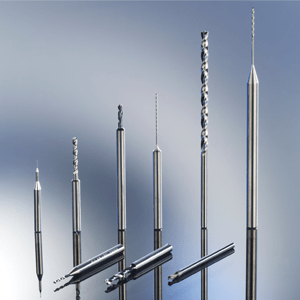La Refinación del Microtaladrado
La industria médica lleva los límites de precisión de mecanizado y herramientas al máximo. La tendencia hacia cirugías menos invasivas usando piezas más pequeñas se traduce en la necesidad de controlar mejor la precisión y tolerancias de los procesos de micromecanizado. Sobre todo, cualquier aplicación de microcorte debe ser altamente estable y libre de vibraciones.
La microperforación se refiere a la dimensión a escala micrométrica del volumen de corte producido con cada trayectoria de la herramienta, no al tamaño de la pieza que se está mecanizando. El microcorte se puede usar para crear piezas en miniatura, pequeñas o grandes con cortes muy precisos. Los productos de BIG DAISHOWA están dentro del rango aceptado por la industria para microperforación: diámetro inicial de 0,50-2,5 mm (0,002-0,10"), disponibles como brocas micro y brocas de centrado en incrementos de 0,010 mm (0,00040"). Por debajo de un diámetro de 0,05 mm, deben usarse soluciones alternativas al taladrado, como el taladrado por láser.
La microperforación requiere una sensibilidad muy alta y una resolución fina en el eje de avance. El husillo de la máquina debe ser capaz de rotar a alta velocidad con un descentrado dinámico muy bajo. Los talleres que deseen hacer la transición a microperforación deben comprar herramientas específicamente para micromecanizado o dedicar y calificar una herramienta en el taller que sea capaz de un descentrado dinámico muy bajo y avances suficientemente finos.
Por ejemplo, para herramientas de microperforación, recomendamos un descentrado máximo de menos de 0,00025 mm (0,000111") de descentrado total indicado (TIR), medido a cuatro veces el diámetro. El TIR se mide en dos direcciones: el descentrado radial (oscilación del husillo en la punta) y el descentrado axial (movimiento del husillo perpendicular a la dirección de rotación), usando tecnología de sensor de capacitancia sin contacto. El TIR es la distancia medida entre la dirección máxima positiva y la máxima negativa.
Aunque algunos usuarios consideran que la tecnología shrink-fit es el método más confiable para asegurar un descentrado aceptable, nuestros estudios concluyen que no es el enfoque óptimo. Sugerimos inspeccionar el TIR cada vez que se cambie una herramienta. Las pinzas de precisión fabricadas a Clase AA pueden proporcionar un descentrado estable y facilidad en el cambio de herramienta.
En microperforación, la concentricidad entre el vástago, la punta de la broca y los márgenes de la herramienta debe mantenerse con tolerancias casi perfectas. Hemos observado que muchos usuarios optan por sujetar brocas con dimensiones de vástago comunes (por ejemplo, vástago de 3 mm y diámetro de broca), también conocido como enfoque de hilo. En este caso, es mejor rectificar la broca para asegurar un descentrado bajo y muy estable. La alternativa usa herramientas con vástago estándar con una variedad de tamaños de punta de broca. El enfoque de broca de hilo tiene un costo de fabricación relativo menor, pero requiere una gama más amplia de tamaños de pinzas para acomodar brocas de diferentes diámetros. Además, debido al diámetro exterior más pequeño, su manipulación es más desafiante. La calidad superficial de las herramientas debe ser muy suave, por lo que se usa un grado ultrafino de carburo sólido, con tamaños de grano en el rango nanométrico, para asegurar alta resistencia a la abrasión y alta tenacidad. Las herramientas con calidad superficial ultrafina producirán un desgaste más uniforme a lo largo de diversas aristas de corte. Con un desgaste más uniforme, se reduce la fuerza requerida para evacuar las virutas y se minimiza la posibilidad de que estas se adhieran a las flautas por efecto del calor.
Seleccionar el material a taladrar según la herramienta de corte es similar a las operaciones de taladrado convencionales, excepto que en microperforación las aristas de corte deben ser muy afiladas y perfectamente centradas. Las tolerancias más estrictas en los agujeros han llevado a la industria a desarrollar herramientas de acabado, incluyendo microavellanado y escariado, para mejorar el acabado superficial típico de 20 RMS creado con taladrado. Una vez establecidos los fundamentos del proceso de microperforación—incluyendo control de avance, descentrado de husillo y portaherramientas, material y geometría de la herramienta, y datos de corte—el microavellanado y escariado para mantener tolerancias de 0,0001" se convierte en una especificación manejable.
Finalmente, los recubrimientos depositados por PVD (deposición física de vapor) en un espesor de <0,001 mm pueden usarse para minimizar el desgaste de las microbrocas. Sin embargo, según nuestra experiencia, si dichos recubrimientos se aplican incorrectamente, pueden ocasionar roturas. Esto se debe a que el recubrimiento reduce la nitidez de la arista de corte, aumentando la fuerza de torque sobre la broca. Si es necesario, consulte con el fabricante de herramientas de corte para un especialista en recubrimientos PVD.
¿Te pareció interesante o útil? Haznos saber tu opinión agregando tus comentarios o preguntas a continuación.






Añadir nuevo comentario